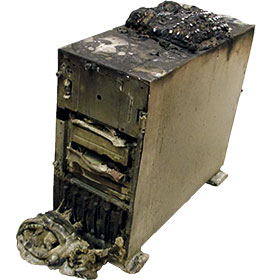

Heat has always been an issue with electronics. As the components get hotter they begin to behave erratically until they fail completely. The CPU is the most important component of a PC and the component that receives the most attention with cooling heatsinks and fans.
In some cases, use is even made of liquid cooling systems to cool CPUs that are overclocked, but fans are noisy and even the best designed fan and computer case do not completely eliminate the noise of the fan.
Dust is the next big killer because it is attracted by static to the cooling veins of the heatsinks that are placed on CPUs. Build-up of dust can completely clog the cooling veins, making the heatsink totally useless and even a liability as it can become a fire hazard. Regular maintenance should be done to clean the cooling veins of the CPU and also the power supplies, which are another source of heat within a PC.
In industrial situations, there is often both dust and heat in the environment in which an industrial PC is expected to operate. Industrial computers have always been fitted with removable filters over the fans of the chassis so that they can be regularly cleaned or replaced. However, this does not always happen when it should, with the result that the PC overheats and fails. In a situation where the PC is controlling a production line or factory the cost of the loss of production and downtime can be huge compared to the cost of replacing the filters regularly.
The big issue was always that the power of the CPU generated a lot of heat that had to be dissipated by the heatsink and fans. As CPUs became more powerful their power consumption increased and with it their heat output. Fortunately, PC CPU technology has advanced dramatically and even powerful CPUs such as the Intel i5 are now available with relatively low heat signatures. This has led to the advent of fanless PCs.
By using better heatsinks and other methods, the heat from the CPU is dissipated through the chassis of the PC and no fans are required. The chassis of the PC can be completely closed, thus excluding dust and ensuring quiet operation and freedom from maintenance of fan filters and heatsinks.
For industrial users, this means that PCs can be installed close to the production line without extra enclosures and cooling. In situations where a PC must be placed in a remote location, it means that the reliability of the PC is improved and less monitoring or maintenance is required.
Centurion Micro Electronics can supply a range of fanless PCs and panel PCs for industrial and commercial use.
For more information contact Henry Hugo, Centurion Micro Electronics, +27 (0)83 581 4549, [email protected], www.cme.co.za
| Tel: | +27 12 666 9066/8 |
| Email: | [email protected] |
| www: | www.cme.co.za |
| Articles: | More information and articles about Centurion Micro Electronics |

© Technews Publishing (Pty) Ltd | All Rights Reserved